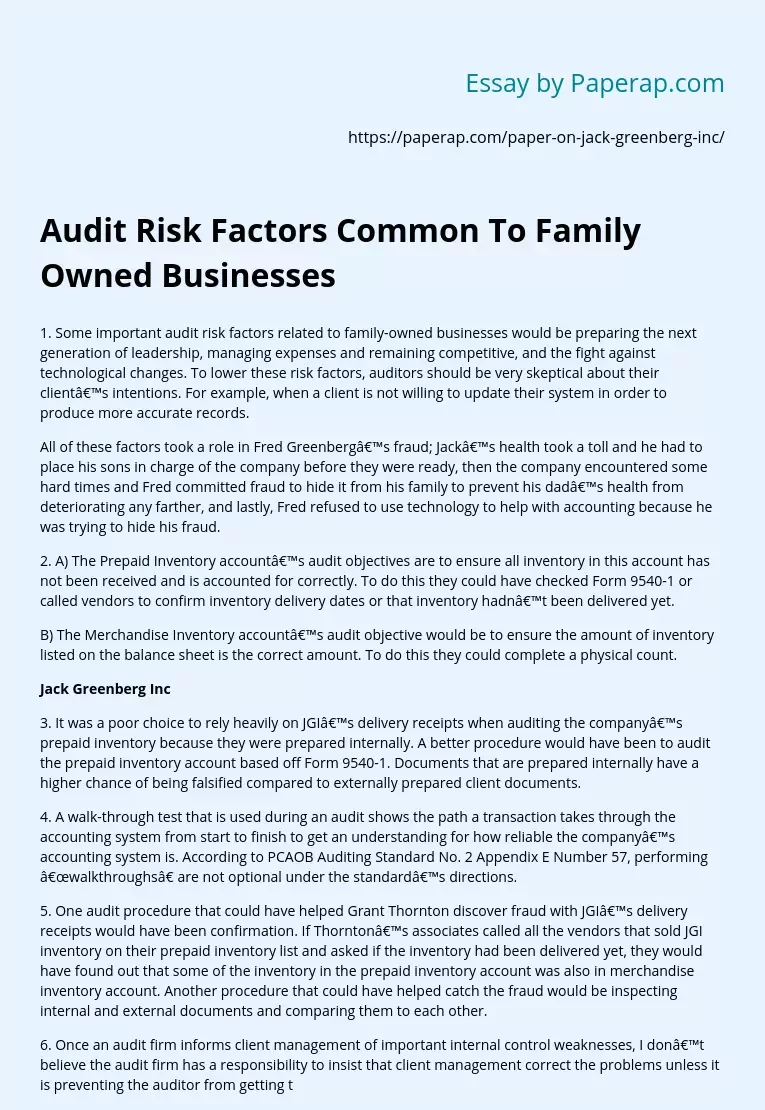Audit Risk Factors Common To Family Owned Businesses
1. Some important audit risk factors related to family-owned businesses would be preparing the next generation of leadership, managing expenses and remaining competitive, and the fight against technological changes. To lower these risk factors, auditors should be very skeptical about their client’s intentions. For example, when a client is not willing to update their system in order to produce more accurate records.
All of these factors took a role in Fred Greenberg’s fraud; Jack’s health took a toll and he had to place his sons in charge of the company before they were ready, then the company encountered some hard times and Fred committed fraud to hide it from his family to prevent his dad’s health from deteriorating any farther, and lastly, Fred refused to use technology to help with accounting because he was trying to hide his fraud.
2. A) The Prepaid Inventory account’s audit objectives are to ensure all inventory in this account has not been received and is accounted for correctly.
To do this they could have checked Form 9540-1 or called vendors to confirm inventory delivery dates or that inventory hadn’t been delivered yet.
B) The Merchandise Inventory account’s audit objective would be to ensure the amount of inventory listed on the balance sheet is the correct amount. To do this they could complete a physical count.
Jack Greenberg Inc
3. It was a poor choice to rely heavily on JGI’s delivery receipts when auditing the company’s prepaid inventory because they were prepared internally.
A better procedure would have been to audit the prepaid inventory account based off Form 9540-1. Documents that are prepared internally have a higher chance of being falsified compared to externally prepared client documents.
4. A walk-through test that is used during an audit shows the path a transaction takes through the accounting system from start to finish to get an understanding for how reliable the company’s accounting system is. According to PCAOB Auditing Standard No. 2 Appendix E Number 57, performing “walkthroughs” are not optional under the standard’s directions.
5. One audit procedure that could have helped Grant Thornton discover fraud with JGI’s delivery receipts would have been confirmation. If Thornton’s associates called all the vendors that sold JGI inventory on their prepaid inventory list and asked if the inventory had been delivered yet, they would have found out that some of the inventory in the prepaid inventory account was also in merchandise inventory account. Another procedure that could have helped catch the fraud would be inspecting internal and external documents and comparing them to each other.
6. Once an audit firm informs client management of important internal control weaknesses, I don’t believe the audit firm has a responsibility to insist that client management correct the problems unless it is preventing the auditor from getting the necessary information needed to perform the audit. It’s the auditor’s duty to ensure that financial data is reported correctly with the standards, not to set up internal controls.
Audit Risk Factors Common To Family Owned Businesses. (2019, Dec 05). Retrieved from https://paperap.com/paper-on-jack-greenberg-inc/

